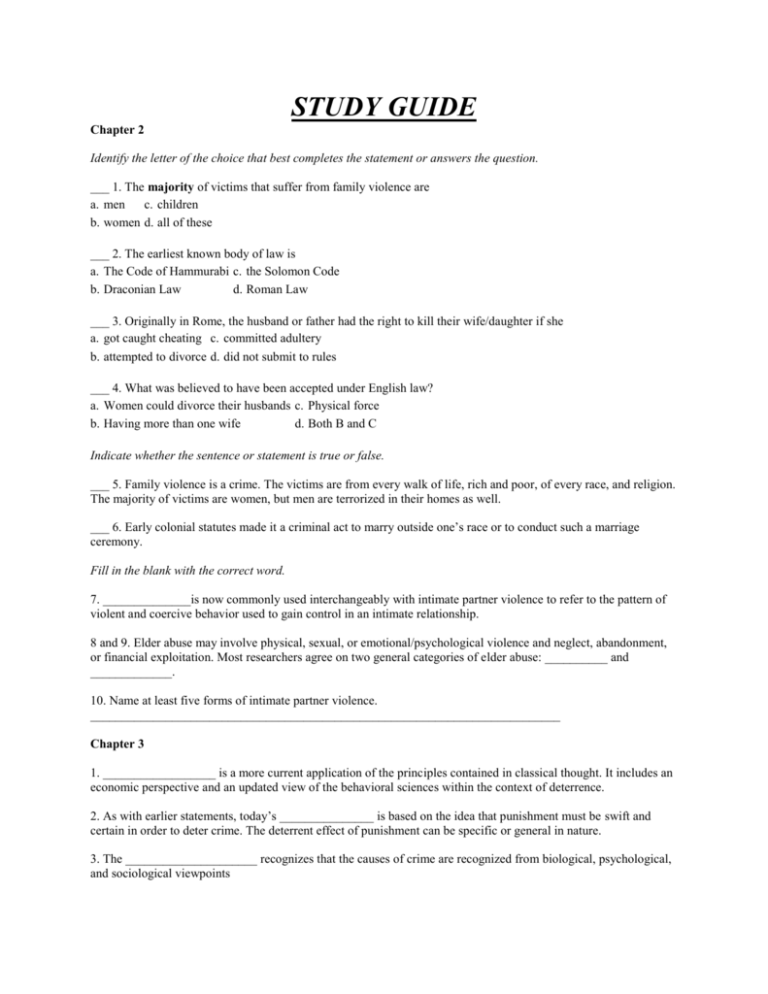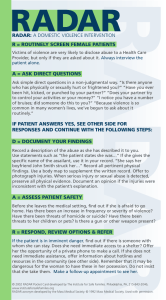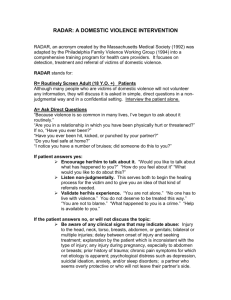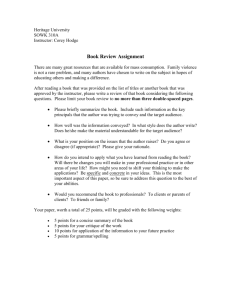Chapter 2 - JBushHCC
advertisement

STUDY GUIDE Chapter 2 Identify the letter of the choice that best completes the statement or answers the question. ___ 1. The majority of victims that suffer from family violence are a. men c. children b. women d. all of these ___ 2. The earliest known body of law is a. The Code of Hammurabi c. the Solomon Code b. Draconian Law d. Roman Law ___ 3. Originally in Rome, the husband or father had the right to kill their wife/daughter if she a. got caught cheating c. committed adultery b. attempted to divorce d. did not submit to rules ___ 4. What was believed to have been accepted under English law? a. Women could divorce their husbands c. Physical force b. Having more than one wife d. Both B and C Indicate whether the sentence or statement is true or false. ___ 5. Family violence is a crime. The victims are from every walk of life, rich and poor, of every race, and religion. The majority of victims are women, but men are terrorized in their homes as well. ___ 6. Early colonial statutes made it a criminal act to marry outside one’s race or to conduct such a marriage ceremony. Fill in the blank with the correct word. 7. ______________is now commonly used interchangeably with intimate partner violence to refer to the pattern of violent and coercive behavior used to gain control in an intimate relationship. 8 and 9. Elder abuse may involve physical, sexual, or emotional/psychological violence and neglect, abandonment, or financial exploitation. Most researchers agree on two general categories of elder abuse: __________ and _____________. 10. Name at least five forms of intimate partner violence. ___________________________________________________________________________ Chapter 3 1. __________________ is a more current application of the principles contained in classical thought. It includes an economic perspective and an updated view of the behavioral sciences within the context of deterrence. 2. As with earlier statements, today’s _______________ is based on the idea that punishment must be swift and certain in order to deter crime. The deterrent effect of punishment can be specific or general in nature. 3. The _____________________ recognizes that the causes of crime are recognized from biological, psychological, and sociological viewpoints 4. ________________________ is the struggle between desires and the ability to fulfill them. 5. According to _______________, people are not born with violent tendencies. They learn them through their environment and life experiences. Identify the letter of the choice that best completes the statement or answers the question. ___ 6. Common goal(s) of research are: a. for the advancement of general knowledge c. to define the social problem b. for the purpose of solving specific problems d. Both A & B ___7. What are examples of research methods used in the criminal justice field? a. Quantitative c. Multidimensional b. Qualitative d. Both A and B ___ 8. The National Crime Victimization Survey a. is conducted by the National Information Reference Service. c. collects information on police arrests. b. is conducted by the Bureau of Justice Statistics. d. documents court dispositions. ___9. Which of the following is a form of quantitative research? a. survey design c. applied research b. descriptive research d. all of the above ___10. The major source of information on criminal victimization is called the: a. National Crime Victimization Survey c. The National Incident Based Reference Service b. The Uniform Crime Reports d. none of the above ___11. The major source of official information on crime comes from: a. National Crime Victimization Survey c. The National Incident Based Reference Service b. The Uniform Crime Reports d. none of the above Chapter 4 1. _____________ is frequently defined in terms of deprivation of adequate food, clothing, shelter, medical care or supervision. 2-5. There are four subcategories of neglect: ________________________________________. 6. _______________________ is the legislative requirement that certain professionals must report cases of suspected child abuse or neglect for investigation to a designated authority within a specified period of time. ___ 7. For a child, emotional abuse can include a. excessive parental behavior. c. Lack of praise. b. aggressive parental behavior. d. all of these. ___ 8. Child protective services (CPS) are required by all states to investigate reports of a. child abuse c. neglect b. ignorance d. both A and C ___ 9. Emotional or psychological abuse involves a pattern of behavior that impairs a child’s a. ability to grow up. c. sense of well-being. b. emotional development. d. both B and C. Chapter 5 ___ 1. The most common dangerous weapon is a. a belt. c. a bat. b. a flyswatter. d. the hand. ___ 2. Shaken Baby Syndrome a. is a relatively new classification of death or injury to infants. b. is the medical term used to describe the violent shaking of a child and the injuries that can occur. c. is common in the United States more than any other county. d. both A and B. ___ 3. A child will suffer a burn a. in the same amount of time as an adult. c. in less time than an adult. b. in the same amount of time as a teenager. d. in more time than an adult. Indicate whether the sentence or statement is true or false. ___ 4. Interviewing alleged victims is a task that requires a thorough knowledge of children’s age and developmental levels. ___ 5. Criminal prosecution of physical abuse is less common than the prosecution of emotional maltreatment. ___ 6. Gathering information on the nature, type, and location of injury is the first step toward a determination of physical abuse. ___ 7. Infants who are mobile are not capable of inflicting severe injury to their bodies. ___ 8. Common household items are frequently used as weapons against children in abusive situations. 9. _____________ includes looking at the victim in various stages of undress. The victims may or may not be aware that the perpetrator is watching them 10. ______________ means that a person is fit to stand trial or to take the oath to tell the truth for testimony in court. Chapter 6 1.____________ theory focuses primarily on family behavior and seeks to identify the problems that are a consequence of dysfunctional relationships among family members. 2. The intergenerational ____________________ asserts that abused children are more likely to become abusers themselves than those who are not abused. ___ 3. Research and theory suggests that some forms of victimization increase the risk of a. juvenile criminal offending. c. arson. b. adult criminal offending. d. continued abuse through generations to come. ___ 4. Family-based theories are examples of a. single dimensional theories. c. multidimensional theories. b. theoretical approaches. d. both A and C. ___ 5. Who is the most critical factor in the development of children? a. Siblings c. Teachers b. Parents d. Peers ___ 6. Chronic physical abuse can result in long term a. physical disabilities. c. hearing loss. b. Brain damage. d. all of these. ___ 7. The consequences of abuse will vary according to all of the following factors except a. characteristics of the child. c. type of trauma b. the way a child is raised to be an adult. d. co-occurrences of types of abuse and neglect. ___ 8. Which abused children are at an increased risk of developing delinquent behavior? a. sexually abused children c. physically abused children b. emotionally abuse children d. all of these ___ 9. Recent reports indicate that victimization of children has grave a. social consequences. c. physical consequences. b. sexual consequences. d. mental consequences. ___ 10. During their adolescent years, about how many teens are involved in an abusive relationship? a. One in three. c. One in two. b. Three in five. d. Four in ten. Chapter 7 1. Describe physical and sexual abuse behaviors. _____________________________________________________________________________________________ _____________________________________________________________ 2. Define “intimate partner violence”. _____________________________________________________________________________________________ _____________________________________________________________ 3. What is meant by the term “battering”? _____________________________________________________________________________________________ _____________________________________________________________ 4. _____________________ attribute family violence to psychological problems such as personality disorders, the batterer’s childhood experiences, or biological disposition. 5. The ___________________ is an integrated theory that brings together three general approaches to crime causation: social learning, unequal power relations, and personal choice theory ___ 6. Intimate partner violence can also be referred to as a. domestic violence. c. spousal abuse. b. battering. d. all of these. ___ 7. Physical abuse behaviors do NOT include a. punching. c. asking for some kind of abuse. b. shoving. d. use of an object against a spouse. ___ 8. Intimate partner violence occurs more often and more severe in a. economically hindered neighborhoods. c. neighborhoods where there are more males than females. b. neighborhoods with minority. d. neighborhoods where women do not speak out about violence. ___ 9. Intimate partner violence is believed to be the primary cause of a. divorce. c. the development of chronic offenders. b. homelessness. d. economic issues in families. ___ 10. The first shelter in the United States opened for battered women in a. St. Paul, Minnesota. c. Albany, New York. b. Chicago, Illinois. d. Baltimore, Maryland. Chapter 8 ___ 1. If the crime is not reported to the police, a. the offenders may be more likely to recidivate c. the victim is at risk for further victimization b. official data is less useful d. all of the above ___ 2. Police have a duty to enforce domestic violence restraining orders that were issued from another state under the Violence Against Women Act (VAWA), passed by Congress as part of the Federal Crime Bill of 1994. This is known as: a. Double Credit c. Full Faith and Credit b. Equal Enforcement d. True Credit ___ 3. Same sex intimate partner violence includes: a. physical abuse. c. identity abuse. b. emotional abuse. d. all forms of intimate violence regardless of the sexual orientation of the individuals. ___ 4. This term refers to the condemnation, loathing, fear, societal disdain, and religious rejection of all things homosexual and of those who practice it a. Internalized homophobia c. Homonegativity b. Homophobia d. Heterophobia 5. Unlike battering, ________ abuse is when both people in the battering relationship are equally responsible as perpetrator and victim. 6. ____________ issues among same-sex partners may differ from those in heterosexual relationships necessitating nonjudgmental approaches consistent to the secretive and guarded tendencies that exist within these non-traditional lifestyles. 7-8. The feminist model of __________and _____________ is often used to describe the context of battering within a lesbian relationship. Chapter 9 1. ______________ is defined by intentional actions that cause harm or risk serious harm or to a vulnerable elder by a caregiver or a failure to satisfy the elder’s basic needs. 2. Abuse of an elder who lives in a residential home for older persons such as a nursing home, foster home, or group home is termed ___________ abuse. 3. ___________ is a term used to describe the deterioration of intellectual faculties, such as memory, concentration, and judgment. 4. Inflicting or threatening to inflict, physical pain or injury on a vulnerable elder, or depriving them of a basic need is referred to as _____________ abuse. 5. Inflicting mental pain anguish or distress on an older adult through verbal or non verbal acts constitutes_____________ abuse. 6. _____________ is the refusal or failure by those responsible to provide food, shelter, health care or protection for a vulnerable older adult. 7. _______________ is the intentional and permanent desertion of an elder in any place (such as a hospital, nursing facility, shopping center, or public location) or leaving the person without the means or ability to obtain necessary food, clothing, shelter, health care, or financial support. 8. ___________________ make the final decision on criminal complaints and must consider the status of each person as well as the severity of the abuse. ___ 9. Definitions of elder maltreatment fall into which category? a. Family or domestic c. Self-neglect or self-abuse b. Institutional d. All of the above ___ 10. There are no federal laws to specifically protect elders from abuse. Chapter 10 1. Studies indicate a strong relationship between ___________ and/or drugs and intimate partner violence committed by men against women. 2. Demands that the victim not work and denial of transportation to leave the home are extreme forms of ______________. 3. The criterion of a suspect initiating 3 or more instances of violence in the preceding year is used to identify ________________ cases. ___ 4. After an abusive attack, it is not unusual for the offender to what? a. leave for an extended period of time c. turn themselves over to the police b. beg for forgiveness d. instantly abuse again ___ 5. Which is not a descriptor or tactic used by abusers? a. manipulation c. controlling behaviors b. depression d. isolation ___ 6. Use of derogatory language in addressing one’s partner is not legally prohibited, but usually signifies emotional abuse. ___ 7. Of all the types of offenders, the antisocial batterer is the least dangerous. ___ 8. Though there are many causes for both substance abuse and for intimate partner violence, little evidence suggests that one problem causes the other. ___ 9. Major studies on dating violence find that women have the same or higher levels than men of both inflicting and sustaining physical dating violence. ___ 10. Results from the NCVS indicate that males are the majority of offenders of intimate partner violence and females are the primary victims. Chapter 11 ___ 1. An officer has the task of determining if probable cause exists to believe that a crime has been committed and that an arrest is warranted. ___ 2. Places that are covered by the Fourth Amendment protection that can be searched without a warrant include common areas, entranceways, public places, semipublic places, open fields, and driveways ___ 3. The plain-view doctrine justifies seizure of items that were not anticipated during the course of a search pursuant to a warrant. ___ 4. The three basic phases to the interview process are preparation, establishment of the psychological content, and the actual questioning ___ 5. Police departments require specialized domestic violence training for officers a. during both in-service and recruit training. c. only if officers are interested in domestic violence. b. once a month. d. training time varies between police departments. ___ 6. In a study on the law enforcement response to domestic violence calls, its authors report that most police departments written policies include a. procedures regarding the arrest decisions. c. handling of violations of protection orders. b. conducting on-scene investigations. d. all of these. ___ 7. Who is most likely to collect evidence to turn over prosecutors and get the victims to testify in courts? a. Specialized Domestic Violence Units c. Undercover Domestic Violence Units b. Private Investigators d. Detectives ___ 8. Why might it be necessary to remove possible suspects right away from the scene of the incident? a. Mental Health Codes c. Civil Protection Codes b. Probable Cause d. None of these ___ 9. Which of these is not a part of the interview process? a. Preparation c. Intervention b. Establishment of the psychological content d. Questioning 10. ____________________________ is a standard of proof that must be satisfied for any search or seizure to occur. An arrest is legally defined as a seizure and therefore falls under the same requirement for probable cause as a search. Chapter 12 ___ 1. What is defined as the killing of a human being by the act, procurement, or omission of another human being? a. Murder c. Patricide b. Homicide d. Parricide ___ 2. The groups that are most likely to be violent and stalk others are those that have had an intimate relationship those who are jealous of the victim because they are in a a. c. with the victim. different relationship. those that wish they had a relationship with the b. d. those that hated being noticed by the victim. victim. ___ 3. Stalking is a crime that is perpetrated by a. men. c. teenagers. b. women. d. stalking has no specific perpetrators. ___ 4. Stalking is different from the majority of crimes because if consists of a. one single act. c. a pattern of actions. b. a series of actions. d. none of the above. ANS: B ___ 5. Elements in the crime of stalking include a. following the victim. c. threatening the victim. b. harassing the victim. d. all of these. ___ 6. The one trait all stalkers have in common is that a. they were stalked themselves previously in their lives. c. they suffer from a personality or mental disorder. b. they will never stalk someone just once. d. none of these. ___ 7. Which homicide is the intentional taking of another’s life that is lawful, such as police officers responding to the commission of a felony with deadly force that could not be avoided? a. Justifiable c. Felonious b. Excusable d. None of these ___ 8. According to the Stalking Resource Center, the District of Columbia and of the states have statutes establishing a civil order specific for protection of stalking victims. a. none c. a few b. the majority d. all ___ 9. A batterer’s are among the strongest predictors of femicide. a. unemployment c. threats of violence b. access to guns d. all of the above







